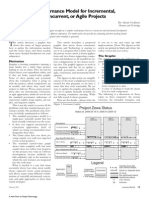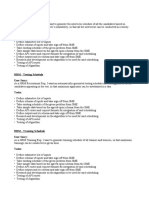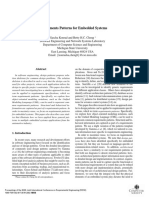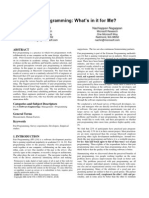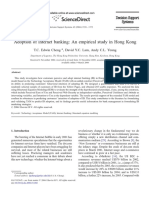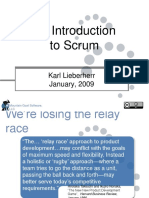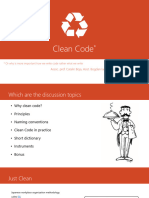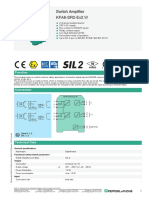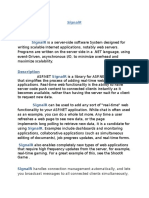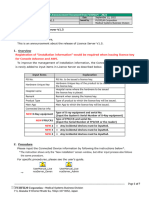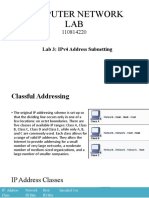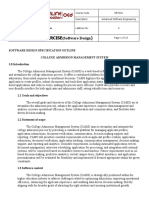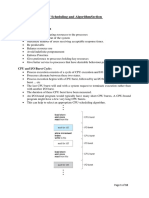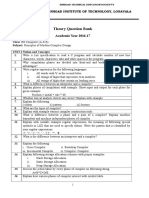Extreme Programming
IanSommerville2004
SoftwareEngineering,7thedition.Chapter17Slide1
�Agile methods
Dissatisfaction with the overheads involved in design
methods led to the creation of agile methods. These
methods:
Focus on the code rather than the design;
Are based on an iterative approach to software
development;
Are intended to deliver working software quickly and
evolve this quickly to meet changing requirements.
Agile methods are probably best suited to
small/medium-sized business systems or PC
products.
IanSommerville2004
SoftwareEngineering,7thedition.Chapter17Slide2
�Principles of agile methods
IanSommerville2004
SoftwareEngineering,7thedition.Chapter17Slide3
�Problems with agile methods
It can be difficult to keep the interest of customers
who are involved in the process.
Team members may be unsuited to the intense
involvement that characterises agile methods.
Prioritising changes can be difficult where there are
multiple stakeholders.
Maintaining simplicity requires extra work.
Contracts may be a problem as with other
approaches to iterative development.
IanSommerville2004
SoftwareEngineering,7thedition.Chapter17Slide4
�Extreme programming
Perhaps the best-known and most widely
used agile method.
Extreme Programming (XP) takes an
extreme approach to iterative development.
New versions may be built several times per
day;
Increments are delivered to customers every 2
weeks;
All tests must be run for every build and the
build is only accepted if tests run successfully.
IanSommerville2004
SoftwareEngineering,7thedition.Chapter17Slide5
�Selec
Bre
storie
Pl
stor
relea
Evalu
Rel
De
r
syste
soft
te
The XP release cycle
IanSommerville2004
SoftwareEngineering,7thedition.Chapter17Slide6
�Extreme programming practices 1
Incremental planning
Requirements are recorded on Story Cards and the Stories to be
included in a release are determined by the time available and
their relative priority. The developers break these Stories into
development Tasks.
Small Releases
The minimal useful set of functionality that provides business
value is developed first. Releases of the system are frequent and
incrementally add functionality to the first release.
Simple Design
Enough design is carried out to meet the current requirements
and no more.
Test first development
An automated unit test framework is used to write tests for a new
piece of functionality before that functionality itself is
implemented.
Refactoring
All developers are expected to refactor the code continuously as
soon as possible code improvements are found. This keeps the
code simple and maintainable.
IanSommerville2004
SoftwareEngineering,7thedition.Chapter17Slide7
�Extreme programming practices 2
Pair Programming
Developers work in pairs, checking each others work and
providing the support to always do a good job.
Collective Ownership
The pairs of developers work on all areas of the system, so that
no islands of expertise develop and all the developers own all the
code. Anyone can change anything.
Continuous Integration As soon as work on a task is complete it is integrated into the
whole system. After any such integration, all the unit tests in the
system must pass.
Sustainable pace
Large amounts of over-time are not considered acceptable as the
net effect is often to reduce code quality and medium term
productivity
On-site Customer
A representative of the end-user of the system (the Customer)
should be available full time for the use of the XP team. In an
extreme programming process, the customer is a member of the
development team and is responsible for bringing system
requirements to the team for implementation.
IanSommerville2004
SoftwareEngineering,7thedition.Chapter17Slide8
�XP and agile principles
Incremental development is supported through
small, frequent system releases.
Customer involvement means full-time customer
engagement with the team.
People not process through pair programming,
collective ownership and a process that avoids long
working hours.
Change supported through regular system releases.
Maintaining simplicity through constant refactoring of
code.
IanSommerville2004
SoftwareEngineering,7thedition.Chapter17Slide9
�Customer involvement
Customer involvement is a key part of XP
where the customer is part of the development
team.
The role of the customer is:
To help develop stories that define the
requirements
To help prioritise the features to be implemented
in each release
To help develop acceptance tests which assess
whether or not the system meets its requirements.
IanSommerville2004
SoftwareEngineering,7thedition.Chapter17Slide10
�Requirements scenarios
In XP, user requirements are expressed as
scenarios or user stories.
These are written on cards and the
development team break them down into
implementation tasks. These tasks are the
basis of schedule and cost estimates.
The customer chooses the stories for
inclusion in the next release based on their
priorities and the schedule estimates.
IanSommerville2004
SoftwareEngineering,7thedition.Chapter17Slide11
�Down
First,
Y
o
u
y
then
h
be
thro
card.
After
t
when
y
onto
.
y
Y
o
u
the
Y
o
u
tell
the
If
the
t
ke
a
so it. is
Story card for document downloading
IanSommerville2004
SoftwareEngineering,7thedition.Chapter17Slide12
�XP and change
Conventional wisdom in software engineering is to
design for change. It is worth spending time and
effort anticipating changes as this reduces costs
later in the life cycle.
XP, however, maintains that this is not worthwhile as
changes cannot be reliably anticipated.
Rather, it proposes constant code improvement
(refactoring) to make changes easier when they
have to be implemented.
IanSommerville2004
SoftwareEngineering,7thedition.Chapter17Slide13
�Refactoring
Refactoring is the process of code improvement
where code is reorganised and rewritten to make it
more efficient, easier to understand, etc.
Refactoring is required because frequent releases
mean that code is developed incrementally and
therefore tends to become messy.
Refactoring should not change the functionality of
the system.
Automated testing simplifies refactoring as you can
see if the changed code still runs the tests
successfully.
IanSommerville2004
SoftwareEngineering,7thedition.Chapter17Slide14
�Testing in XP
Test-first development.
Incremental test development from
scenarios.
User involvement in test development and
validation.
Automated test harnesses are used to run all
component tests each time that a new
release is built.
IanSommerville2004
SoftwareEngineering,7thedition.Chapter17Slide15
�T
aT
sk1:
aT
sk2
a
sk3
Paym
fere
Th
select
.
If
has
a
subsc
system
Alter
,
the
ga
accou
.
If
t
of
,
may
i
date.
This
valid
Task cards for document downloading
IanSommerville2004
SoftwareEngineering,7thedition.Chapter17Slide16
�eInput:
T
T
e
edit
st
st
4:
cr
c
A
string
the
mo
eCheck
T
sts:
year
.
is
Using
,
check
card
is
numbe
issuer
Outpu
OK or
Test case description
IanSommerville2004
SoftwareEngineering,7thedition.Chapter17Slide17
�Test-first development
Writing tests before code clarifies the
requirements to be implemented.
Tests are written as programs rather than
data so that they can be executed
automatically. The test includes a check that
it has executed correctly.
All previous and new tests are automatically
run when new functionality is added. Thus
checking that the new functionality has not
introduced errors.
IanSommerville2004
SoftwareEngineering,7thedition.Chapter17Slide18
�Pair programming
In XP, programmers work in pairs, sitting together to
develop code.
This helps develop common ownership of code and
spreads knowledge across the team.
It serves as an informal review process as each line
of code is looked at by more than 1 person.
It encourages refactoring as the whole team can
benefit from this.
Measurements suggest that development
productivity with pair programming is similar to that
of two people working independently.
IanSommerville2004
SoftwareEngineering,7thedition.Chapter17Slide19
�Problems with XP
Customer involvement
This is perhaps the most difficult problem. It
may be difficult or impossible to find a customer
who can represent all stakeholders and who can
be taken off their normal work to become part of
the XP team. For generic products, there is no
customer - the marketing team may not be
typical of real customers.
IanSommerville2004
SoftwareEngineering,7thedition.Chapter17Slide20
�Problems with XP
Architectural design
The incremental style of development can mean that
inappropriate architectural decisions are made at an early
stage of the process.
Problems with these may not become clear until many
features have been implemented and refactoring the
architecture is very expensive.
Test complacency
It is easy for a team to believe that because it has many
tests, the system is properly tested.
Because of the automated testing approach, there is a
tendency to develop tests that are easy to automate rather
than tests that are good tests.
IanSommerville2004
SoftwareEngineering,7thedition.Chapter17Slide21
�Key points
Extreme programming includes practices such as
systematic testing, continuous improvement and
customer involvement.
Customers are involved in developing requirements
which are expressed as simple scenarios.
The approach to testing in XP is a particular strength
where executable tests are developed before the
code is written.
Key problems with XP include difficulties of getting
representative customers and problems of
architectural design.
IanSommerville2004
SoftwareEngineering,7thedition.Chapter17Slide22



